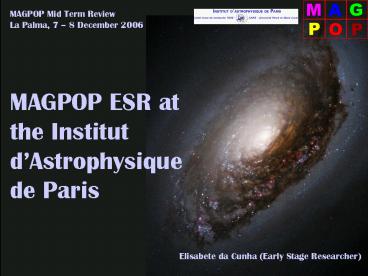MAGPOP ESR at the Institut dAstrophysique de Paris PowerPoint PPT Presentation
1 / 14
Title: MAGPOP ESR at the Institut dAstrophysique de Paris
1
MAGPOP Mid Term Review La Palma, 7 8 December
2006
MAGPOP ESR at the Institut dAstrophysique de
Paris
Elisabete da Cunha (Early Stage Researcher)
2
SHORT PROFILE
- Nationality Portuguese
- Previously at the Faculty of Sciences of the
University of Porto (Portugal) degree (July
2005) in Physics/Applied Mathematics (Astronomy) - Broad background in Physics and Mathematics
- Cosmology, Extragalactic Astronomy,
Observational Astronomy,
- MAGPOP Research Training Network
- 3 year PhD project (10.2005 10.2008)
- Node Institut dAstrophysique de Paris, CNRS,
Université Pierre et Marie Curie Paris VI,
France - Supervisor Stéphane Charlot
- Modelling and interpreting galaxy spectral
energy distributions
1
3
SCHOOLS
École Doctorale dÎle de France (Doctoral School)
- 1st year
- Numerical simulations and parallel calculus
- Evolution of local and distant galaxies
- Dynamics of galaxies
- 2nd year
- Data analysis
- Cosmology
- Introduction to telescope time proposals
MAGPOP Budapest Summer School (08.2006)
- Observational Astronomy (ground- and
space-based) - Stellar population synthesis models
- Galaxy formation and evolution models
- Practical sessions
- Virtual Observatory
- Telescope time proposals
2
4
ACTIVITIES CONFERENCES
IAP activities
- Annual Thesis Day where PhD students present
their work to other researchers and students in
the IAP.
- Weekly seminars on several subjects.
- Weekly Jornal Club with the Galaxy Group at the
IAP.
Conferences Meetings
- MAGPOP Network Meeting in Toledo, Spain (02.2006)
- ENAA 2006 National Meeting of Portuguese
Astronomical Society in Espinho, Portugal
(07.2006)
3
5
RESEARCH PROJECTS
Current projects and collaborators
- Simple model for the infrared emission by dust
in galaxies with S. Charlot (IAP), D. Elbaz (CEA
Saclay).
- Simple model for the full spectral energy
distributions of galaxies from the ultraviolet to
infrared with S. Charlot (IAP), D. Elbaz (CEA
Saclay).
- Infrared cosmological background/first stars and
galaxies with S. Charlot (IAP), E. Vangioni
(IAP), K. Olive (Univ. Minnesota), F. Daigne
(IAP).
4
6
MODELLING GALAXY SPECTRA
PhD Thesis Modelling and interpretation of the
spectral energy distributions (SEDs) of galaxies
from ultraviolet to infrared wavelengths with
simple models.
- Modelling the SED
- Star formation history
- Dust content
5
7
(No Transcript)
8
MODELLING GALAXY SPECTRA
We are developing a simple, versatile model to
interpret consistently the spectra of galaxies at
ultraviolet, optical and infrared wavelengths in
terms of a set physical parameters describing the
star formation history and the dust content. This
model will be applied to the analysis of large
samples of galaxies. Ultraviolet and optical
emission Stellar populations synthesis models
(Bruzual Charlot) to describe stellar emission
simple prescription for the attenuation by dust
(Charlot Fall). Infrared emission Develop
a simple, physically motivated model for the IR
emission, which allows one to interpret the mid-
and far-infrared emission by dust in galaxies
consistently with the emission at shorter
wavelentghs.
6
9
MODELLING GALAXY SPECTRA
Dust luminosity
- The total luminosity reradiated by dust grains
in a galaxy equal to the total luminosity they
absorb from stars. - Influence of the finite lifetimes of stellar
birth clouds on the absorption of radiation
photons emitted by stars that live longer than
the birth clouds (10 Myr) propagate only
through the ambient ISM before they escape from
the galaxy.
giant molecular clouds in which stars form HII
region (hydrogen ionized by young hot stars) HI
region (neutral hydrogen)
interstellar medium (older and colder stars)
7
10
MODELLING GALAXY SPECTRA Infrared
Dust components
- Polycyclic Aromatic Hydrocarbons (PAHs)
- Organic molecules that have a typical emission
spectrum in the mid-infrared (between 5 and 20
µm). - Very Small Grains (VSGs)
- Small carbonaceous grains that are heated by
the absorption of single photons and reach high
temperatures (several hundreds of K). - Big Grains (BGs)
- Composed mainly of silicates and graphite with
sizes up to 100 nm these grains are in thermal
equilibrium with the radiation field and emit as
modified black bodies.
8
11
MODELLING GALAXY SPECTRA Infrared
Example of a model infrared galaxy spectrum
- TBGsBC
- fµ LdISM / Ldtotal
- ?1 LPAH / LdBC
- ?2 LVSGs(200K) / LdBC
- ?3 LVSGs(80K) / LdBC
- ?4 LBGsBC / LdBC
9
12
MODELLING GALAXY SPECTRA Infrared
NGC 5713
- Spiral galaxy (SABbcp)
- d26.6 Mpc
Result of the fit to ISO and IRAS infrared fluxes
to the model library model SED and comparison
with observations.
10
13
MODELLING GALAXY SPECTRA Infrared
NGC 5713
- Spiral galaxy (SABbcp)
- d26.6 Mpc
Result of the fit to ISO and IRAS infrared fluxes
to the model library probability density
histogram for each parameter of the model.
11
14
NEXT...
- Connect with stellar emission models and with
constraints on the optical attenuation curve (O.
Vince, Budapest Node)
model galaxy spectra in the ultraviolet, optical
and infrared
- Application of the new model to observed samples
of galaxies in the UV, optical and IR (V. Buat,
J. Walcher, Marseille Node T. Heckman, JHU
Node). - Extract information about key physical parameters
related to the star formation history and the
interaction between stellar radiation and dust. - Implications for the evolution of the physical
properties of galaxies (MPA Node).
galaxy formation and evolution models
12

